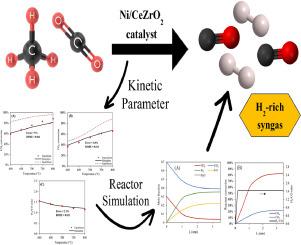使用 Ni/CeZrO2 催化剂对甲烷进行干转化,提高合成气产量:动力学参数研究和富含二氧化碳的进料模拟
IF 5.5
Q1 ENGINEERING, CHEMICAL
引用次数: 0
摘要
纳土纳的天然气储量含有 70%-v CO2 和 30%-v CH4,这为通过甲烷干重整(DRM)生产合成气开辟了前景广阔的方法。本研究利用固定床反应器中的方程和动力学参数的确定来制定 DRM 工艺的操作条件。使用的催化剂为 10 %Ni/CeZrO2 并遵循 Langmuir-Hinshelwood 机理,Ni 催化剂上的 CH4 解离(C-H 键活化)是决定速率的步骤。结果表明,模拟数据和实验数据的误差值≤ 5 %,RMSE < 0.046。这表明模拟中使用的方程和动力学参数在反应器建模中是有效的。然后使用一维准均质模型进行了稳态建模。CO2:CH4 = 70:30(纳土纳气田成分)的进料成分产生了最佳结果,温度为 700 °C,CH4 转化率为 92%,CO2 转化率为 28%,H2/CO 比率为 1.42,碳形成率为 7.1 mgC/gcat。该研究还发现,较高的 CO2:CH4 进料比可减少 DRM 过程中的碳形成。本文章由计算机程序翻译,如有差异,请以英文原文为准。

Enhanced syngas production through dry reforming of methane with Ni/CeZrO2 catalyst: Kinetic parameter investigation and CO2-rich feed simulation
Natuna's natural gas reserve, which contains 70 %–v CO2 and 30 %–v CH4, opens a prospective method for producing syngas through the dry reforming of methane (DRM). This study used the equation and determination of kinetic parameters in a fixed-bed reactor to develop the operating conditions for the DRM process. The catalyst used was 10 %Ni/CeZrO2 and followed the Langmuir-Hinshelwood mechanism, with CH4 dissociation (activation of C–H bonds) on the Ni catalyst as the rate-determining step. According to the results, the simulation and experimental data have error values of ≤ 5 % and RMSE < 0.046. This indicates that the equation and kinetic parameters used in the simulation are valid for reactor modeling. Steady-state modeling was then conducted using a 1D quasihomogeneous model. The feed composition of CO2:CH4 = 70:30 (Natuna gas field composition) has optimized results with temperature 700 °C, CH4 conversion at 92 %, CO2 conversion at 28 %, and H2/CO ratio 1.42, and carbon formation at 7.1 mgC/gcat. This study also found that a higher CO2:CH4 feed ratio could reduce carbon formation during DRM.
求助全文
通过发布文献求助,成功后即可免费获取论文全文。
去求助
来源期刊

Chemical Engineering Journal Advances
Engineering-Industrial and Manufacturing Engineering
CiteScore
8.30
自引率
0.00%
发文量
213
审稿时长
26 days
 求助内容:
求助内容: 应助结果提醒方式:
应助结果提醒方式:


